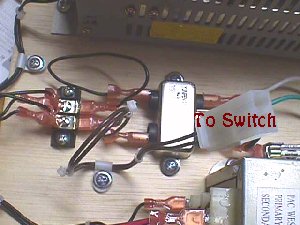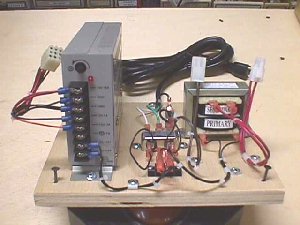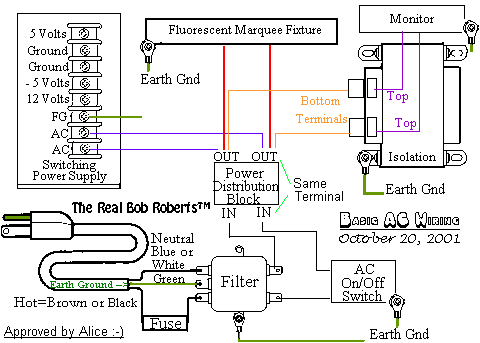K... before adding the missing wires & alternate wiring let me point out the earth ground path. Soooo many Qs have come up about earth ground... repeatedly over the years... that I really want to try to put it to sleep right here :-() Earth ground is just what it sounds like. A conductive pipe or rod is driven into the earth to a minimum depth of 8 feet at your electrical entry box giving you a true earth ground. Other sources of earth ground in your home would be conductive water pipes & cable TV ground... if it was properly installed. Telephone lines are earth grounded, as well, but they are usually parasitic & often attached to entry piping at your home's power meter box.

In the pic above we have earth ground which is carried via the green wire in the AC line cord from your wall outlet through the round middle prong on the plug, up to the middle terminal of your AC line filter. Remember, this terminal is the one that simply is a part of the metal case that houses the actual filter, hence we have the metal housing on your power entry point, your metal water pipes, the metal frame inside your TV set & etc, all hooked directly to your filter's metal case. We have "earth ground" present. Now... any metal in your cab that you want to earth ground can be done easily by simply making a loop to them to complete an electrical path (circuit). One piece of green 18 gauge wire connected from screw #2 to screw #1 will earth ground your switcher. A piece from screw #3 over to screw #4 will include the isolation transformer in this earth ground circuit. Now a wire from screw #5 to your monitor frame or any other metal in your cab will include that piece in the earth ground circuit. Earth ground is earth ground no matter where you find it, so if you wanted to include a metal switch holder in your earth ground circuit you can run a wire from it to any one of the screws marked 1 thru 5 to include it... or even to another cab's metal as long as it was plugged in & properly earth grounded. Want to be earth grounded the hard way.... do your internal wiring & snap off the EG prong on your AC cord & run a wire from any number screw out the window, attach it to an 8 foot metal rod & drive it into the ground! You are earth grounded :-)

K... back to the topic at hand... the purpose of the blank terminals above. I said if a wire was added between the blank terminal on the line filter & the one on the AC distribution block we'd have a 120 volts to distribute to the various components that required it, but... you'd have power all the time that the line cord was plugged in. You'd have to unplug it from the wall to turn the game off, hence, this is where we are going to insert a switch to control the power. A lot of newbies get confused about this because of the rat's nest of wires that are usually found in older games, but it's really simple. You could put a switch right there on the base between the blank terminals... all we need to close the circuit & distribute the 120 VAC to it's destination... but then you'd need to get to the "power center" to turn the game off. Not much better than simply unplugging it it from the wall, so what is needed is to move the switch to a convenient spot for turning the game off & on. Like Atari did when they moved their on/off switch to 6 inches off the floor & dead center on the back of the cab.... wait.... what were they thinking! That's why I put all on/off switches on the top right-hand side of the cab. At most... you only needed a chair to turn it off if you were vertically challenged.
All that is being done here is simply adding 2 wires to get to a remote place of convenience to control power to the game cab. Yes... you can switch both AC lines if you want. The jumper that was added to the first terminal of the AC filter going to the AC distribution block... toss it in file 13 & run a second pair of wires to your on/off switch... which will have to be DPST at least to interupt both lines at the same time.

I said that the 2 blanks in the center of the AC distribution block were to feed the marquee fluorescent fixture, so that only leaves the 2 blanks on the isolation transformer... the secondary output which feeds the 120 VAC isolated to the monitor. K.... we have controllable AC power to everything now. Oh... one other thing inre the switching, that comes up often... interlock switches. If we added 2 more switches into the main switch line in the cab, in series.. daisy chained... all switches would need to be closed in order to complete the circuit & have the game work. These added switches (interlock switches) are placed at the doors of the cab to automatically open up the circuit & shutdown the game when the door is opened. Most have an on position when pulled out in addition to the momentary position held in by the door, so you can repower it without replacing/closing the door.
Time to add the missing wires to the soup!

Although it doesn't look like it in the pic, I use 18 gauge brown wires to go to the remote on/off switch helping to ID them in the harness the same way that blue for marquee power did. The brown wires of the switch line are terminated in a Molex .093 two position connector, but you can run them directly to the switch without a break plug.

The red monitor wires above are terminated in the opposing halve of the Molex connector used for the switch line, so that the lines cannot be mistakenly crossed. As with the switch line, you can run straight to the monitor without this connector in line.

Completed & ready to set in the cab. Notice that a short DC harness has been added to the power supply using a 9 position .093 Molex connector. Positions 1, 2 & 3 are used for 5 volts. Positions 4, 5 & 6 are used for ground. Position 7 is used for - 5 volts & position 8 is used for 12 volts.
You do not need to add this Molex connector, either. The reason that I have break plugs in everything is because if you make more than one game & all the "power centers" are made the same way, it is easy to do a quick swap out to get a game going in a hurry or simply for t-shooting purposes. If you suspect you have a trouble with power a quick change to a known good one will answer your Qs & if there is a problem with the one removed, you can work on it at a work station instead of hanging upside down in the cab trying to figure out what is wrong.
Incidently, did this "power center" look familiar to you? Perhaps you've seen it another way on my site? Hmmmm....

Happy Gaming...